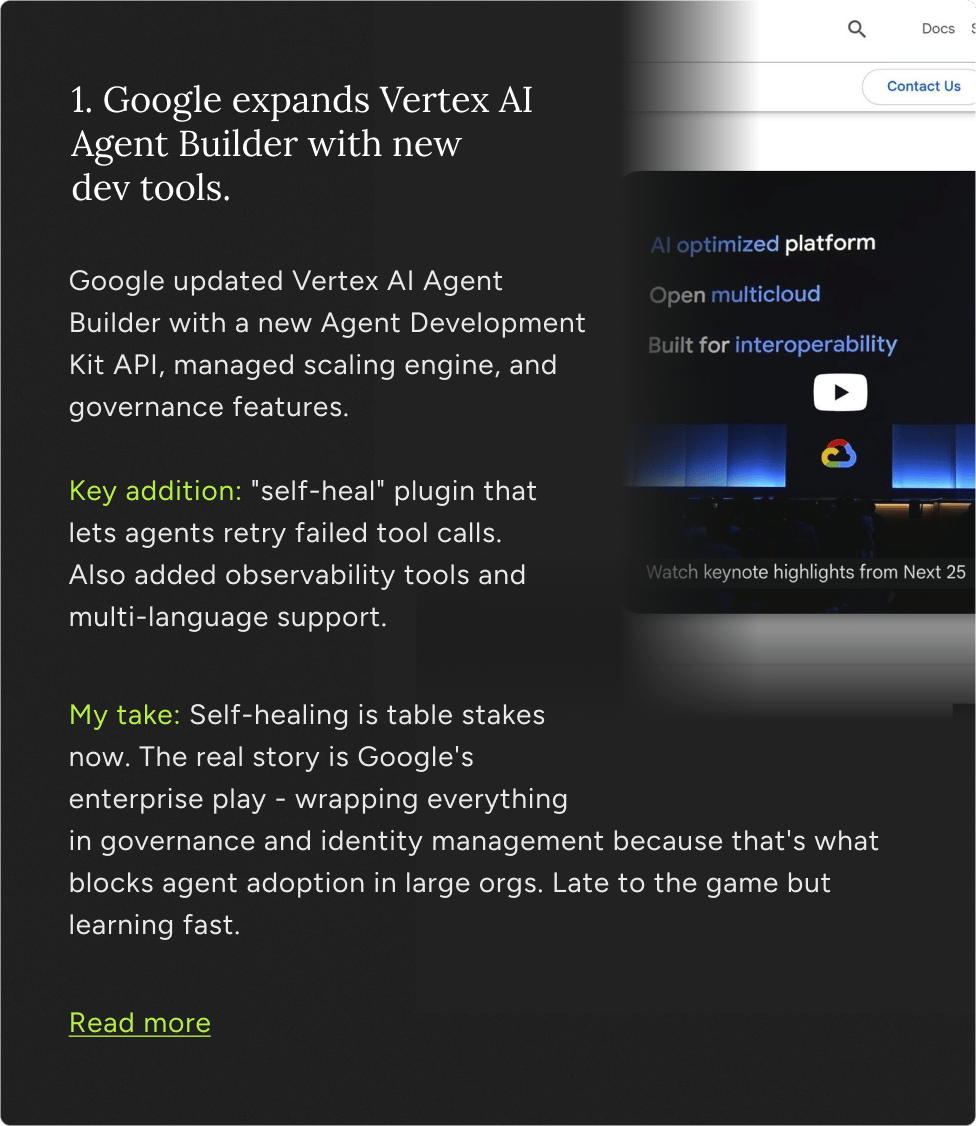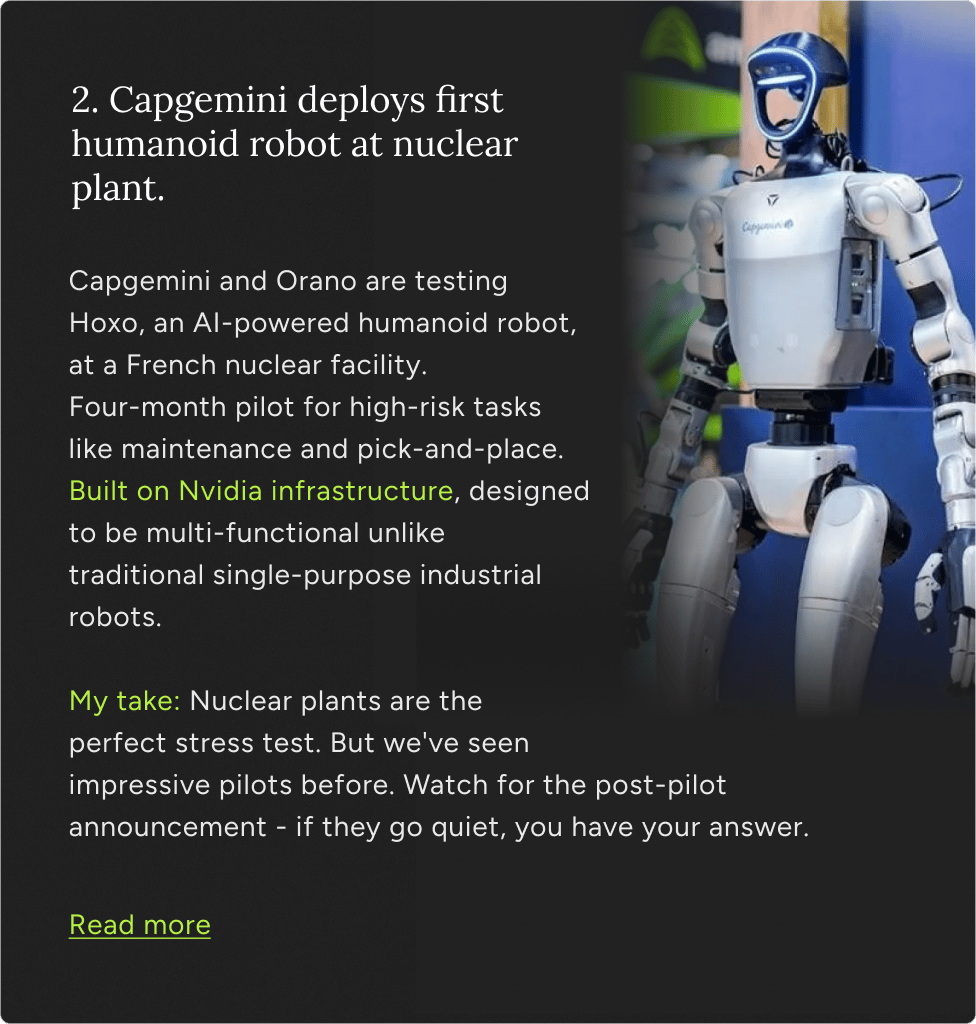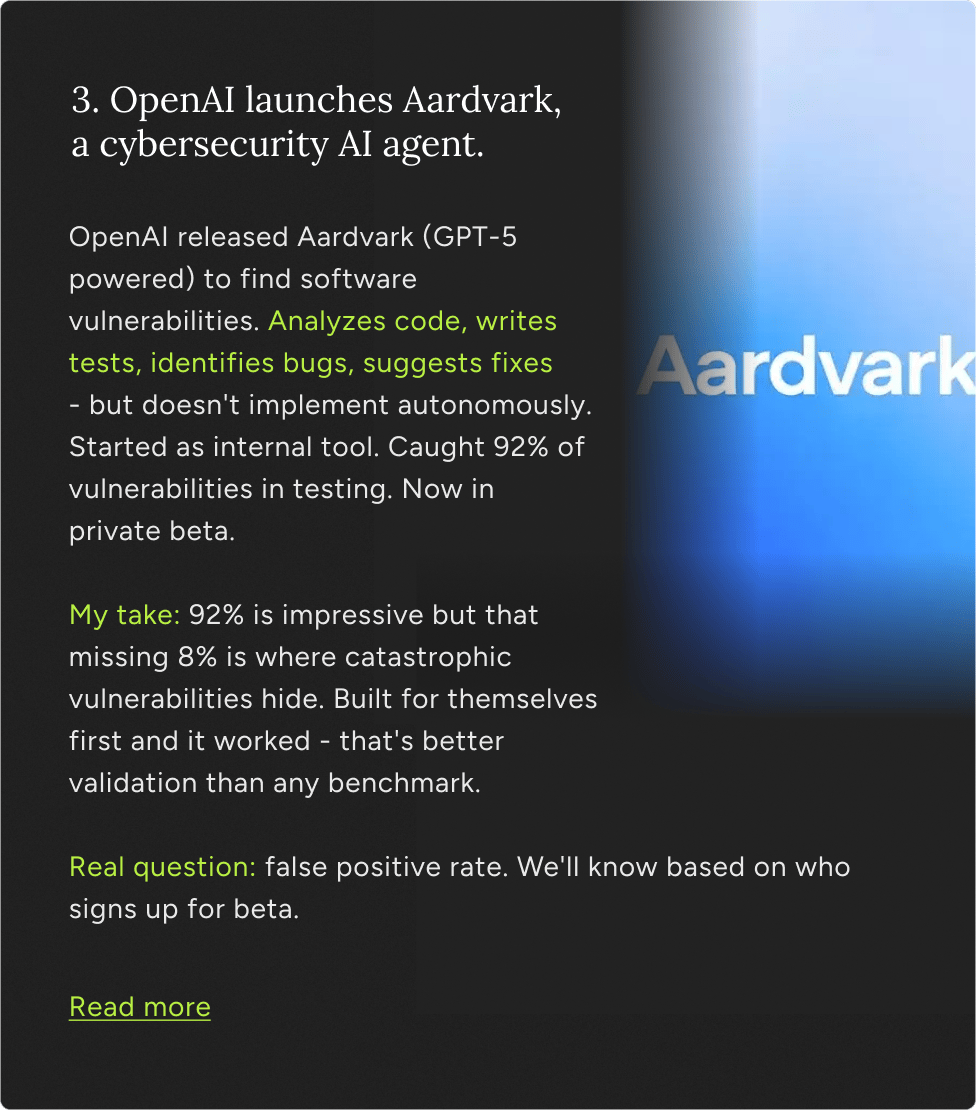
What would convince you an AI agent is worth using?
Two AI Agents walked up to me at the bar.
Both claimed they could automate my work better than the other.
I told them to prove it.
"Make me a presentation and argue why I should pick you.”
Manus went first.
Then Genspark.
Here's what happened when AI agents had to sell themselves.
But first: what happened this week?
TOOLS THAT CAUGHT MY ATTENTION
1. Kimi K2 Thinking: Chinese open-source model beats GPT-5 on benchmarks
A 1 trillion parameter open-source reasoning model claiming SOTA performance. Can execute 200-300 sequential tool calls autonomously, scored 44.9% on Humanity's Last Exam and 60.2% on BrowseComp. Uses native INT4 quantization for 2x speed. Cost to train: $4.6M. Available via API and local deployment at 594GB download.
2. Parse: Turn any website into an API in seconds
It reverse-engineers websites' network requests to generate deterministic APIs - no headless browsers needed. Launched in August, hit 30K users in 3 weeks. Claims 10-100x faster than browser automation, costs fractions of a cent per call. Handles dynamic values, IP rotation, antibot challenges automatically.
3. Freepik Spaces: Node-based AI workflow collaboration
A node-based interface for building and collaborating on AI workflows in real-time. Consolidates image generation, video creation, upscaling, and editing into one canvas. Multiple users can work simultaneously. Available to all Freepik users on desktop and mobile.
Back to the bar
So two AI agents need to prove themselves.
Why presentations?
Because that's what they are known for.
Both Manus and Genspark market presentation generation as a flagship capability.
Manus has "Manus Slides" - reviews call it "McKinsey-level quality."
Genspark has "AI Slides" - promises "boardroom-ready decks."
Time to see if either delivers.
The contenders

The Challenge
Here's the prompt I gave both:
Create a professional presentation making the case for why users should choose [YOUR TOOL] over [COMPETITOR TOOL] for automating complex work tasks.
Include: specific feature advantages, performance comparisons, real use case examples, pricing value proposition, and a compelling conclusion.
Make it persuasive, data-driven, and backed by facts. This should be boardroom-ready.
The meta-test: Can an AI agent sell itself effectively?
Watching them work
Manus: Efficient and Unremarkable
Hit go, watched it work.
The interface showed basic progress - gathering info, structuring slides, generating content. Functional. Clean. Forgettable.
Time: 5-6 minutes.
The vibe: Get it done, move on.
Genspark: Deliberate and Engaging
Hit go, wanted to watch.
The interface showed distinct phases - research mode, data collection, structure planning, slide assembly. Each step visible and intentional.
Time: 10-12 minutes. Twice as long.
The vibe: This is thinking about the problem, not just executing steps.
What they delivered
Opening slides
Manus: Title says “Manus vs Genspark, The Definitive Choice for Complex Work Automation.” It sets the problem as complex, multi step, non standard tasks. It is written as if Manus is already the better platform.
Genspark: Title says “Why Genspark Super Agent is the Superior Choice for Enterprise Automation.” It has date, footer, and looks like it was made for internal decision making. It sets the claim as performance and efficiency, not architecture.
So, both are claiming to be superior, but
Manus frames it as an automation and architecture problem,
Genspark frames it as an enterprise results problem.
The core argument
Manus’ approach:
Says enterprises need AI agents that can plan, execute and deliver end to end inside a sandbox.
Says Manus has a Turing complete environment, shell, file system, code execution, domain tools.
Says Genspark is only an orchestrator of external models, has fixed integration points, cannot access shell or file system, and that every handoff is a possible failure.
Says pricing in Genspark is credit based and becomes unpredictable.
There are no numbers to prove any of this, it is all described.
The argument is, Manus is more capable for novel and deeply technical work.
Genspark approach:
Shows GAIA benchmark table with actual numbers. Genspark 87.8 percent vs Manus 86.5 percent at Level 1, 72.7 vs 70.1 at Level 2, 58.8 vs 57.7 at Level 3.
Shows task completion times for real style tasks like website creation, dashboard, app poster. In every case Genspark is faster.
Shows credit consumption bars where Genspark uses fewer credits and the note says 50 to 80 percent fewer credits.
Later slides show design quality 8 to 9 out of 10 for Genspark vs 6 to 7 out of 10 for Manus.
The argument is, Genspark wins on measured performance, on speed, and on cost per task.
So, Manus says Genspark cannot even do the hard stuff,
but Genspark says not only can it do it, it does it faster and cheaper, and shows numbers.
The design gap
Manus: Mostly text, long explanations, very little visual proof. It reads like a product team deck that is trying to educate on architecture. It talks about “Action Engine,” “sandboxed isolation,” “integrated tools,” but the slides are plain.
Genspark: Every slide is laid out with icons, two or three column sections, charts, callouts, highlighted numbers, source lines. It looks like something you can present to a VP in five minutes.
One needs the audience to read carefully.
The other communicates in one glance.
The evidence
Manus:
Has a section titled “Performance: GAIA Benchmark Results” but does not show the actual GAIA numbers.
States that Manus has lower failure rates on mission critical tasks, that sandboxed isolation prevents interference, that it can self correct.
Also says Genspark cannot access shell, cannot execute arbitrary code, and has mixture of experts fragility.
All of this is plausible for an agent with a real VM, but none of it is demonstrated on the slide.
Genspark:
Gives GAIA numbers for both products, and Genspark leads on every level.
Gives credit consumption numbers and the direction is opposite of the Manus deck. Manus deck says Genspark credits are unpredictable, Genspark deck says Manus uses two to five times more credits.
Gives user and reviewer ratings, 8 to 9 out of 10 for Genspark, 6 to 7 for Manus.
Gives enterprise metrics like 36 million ARR in 45 days, 5 million users, 88 to 92 percent month one retention.
So, Manus asks the audience to trust the internal view.
Genspark gives the audience something to audit.
The pricing story
Manus PDF: Says Manus has transparent usage based pricing, clear per minute compute, and that Genspark credit packs get burned fast on complex tasks. So Manus says it is the predictable one.
Genspark slides: Show the reverse. They say Genspark gives 50 to 80 percent fewer credits per task, and that Manus consumes two to five times more credits, and they show a bar chart of tasks completed per 1000 credits where Genspark completes more tasks.
So the two decks directly contradict each other on pricing and efficiency.
Manus says Genspark is unpredictable.
Genspark says Manus is expensive per outcome.
Full presentations
Manus:
Structure is challenge of complex work, then feature advantage of Manus, then why Genspark falls short, then pricing.
Audience is technical buyers who care about access to shell, file system, autonomous correction, and want to run non standard tasks.
Genspark:
Structure is executive summary, benchmarks, speed and efficiency, use case excellence, reliability and output quality, pricing and value, enterprise advantages, competitive intelligence, conclusion.
Audience is decision makers who want to see that this product is already used, already measured, and fits security and governance.
So, Manus is a capability pitch.
Genspark is a boardroom pitch.
Which one would convince you to sign a contract?
What happened
Genspark won. Better design, better data, more persuasive.
Both agents completed the task. Both generated presentations. Both made arguments.
But they heard completely different instructions.
Manus heard: "Explain your technical superiority." Built slides about sandboxed execution, autonomous reasoning, tool integration. Fast because comprehensiveness was the goal.
Genspark heard: "Convince someone to pick you." Built slides with benchmarks, ROI data, visual proof. Slower because evidence-gathering takes time.
Same prompt. Different interpretation of what "professional" means.
Manus optimized for technical evaluators who care about architecture. Genspark optimized for decision-makers who need proof of value.
One wins technical discussions. The other wins contracts.
The technology works - both agents automated a complex task successfully. What varies wildly: how they interpret what you need.
My take
I'm now using Genspark for a lot of my work. Newsletter content, strategy docs - stuff that needs to convince people. I need data-backed claims, clear visuals, arguments that land with non-technical readers.
If I was writing technical documentation all day, Manus would probably be the better fit. That speed and architectural depth would matter more.
The 5-minute time difference doesn't matter to me when one gives me something I can use and the other gives me something I'd have to rebuild.
The best AI agent? Whichever one gets what you're trying to do.
Go on and try both, and reply with which you end up liking more.
Until next time,
Vaibhav 🤝🏻
If you read till here, you might find this interesting
#AD 1
The AI Race Just Went Nuclear — Own the Rails.
Meta, Google, and Microsoft just reported record profits — and record AI infrastructure spending:
Meta boosted its AI budget to as much as $72 billion this year.
Google raised its estimate to $93 billion for 2025.
Microsoft is following suit, investing heavily in AI data centers and decision layers.
While Wall Street reacts, the message is clear: AI infrastructure is the next trillion-dollar frontier.
RAD Intel already builds that infrastructure — the AI decision layer powering marketing performance for Fortune 1000 brands. Backed by Adobe, Fidelity Ventures, and insiders from Google, Meta, and Amazon, the company has raised $50M+, grown valuation 4,900%, and doubled sales contracts in 2025 with seven-figure contracts secured.
Shares remain $0.81 until Nov 20, then the price changes.
👉 Invest in RAD Intel before the next share-price move.
This is a paid advertisement for RAD Intel made pursuant to Regulation A+ offering and involves risk, including the possible loss of principal. The valuation is set by the Company and there is currently no public market for the Company's Common Stock. Nasdaq ticker “RADI” has been reserved by RAD Intel and any potential listing is subject to future regulatory approval and market conditions. Investor references reflect factual individual or institutional participation and do not imply endorsement or sponsorship by the referenced companies. Please read the offering circular and related risks at invest.radintel.ai.
#AD 2
CTV ads made easy: Black Friday edition
As with any digital ad campaign, the important thing is to reach streaming audiences who will convert. Roku’s self-service Ads Manager stands ready with powerful segmentation and targeting — plus creative upscaling tools that transform existing assets into CTV-ready video ads. Bonus: we’re gifting you $5K in ad credits when you spend your first $5K on Roku Ads Manager. Just sign up and use code GET5K. Terms apply.













